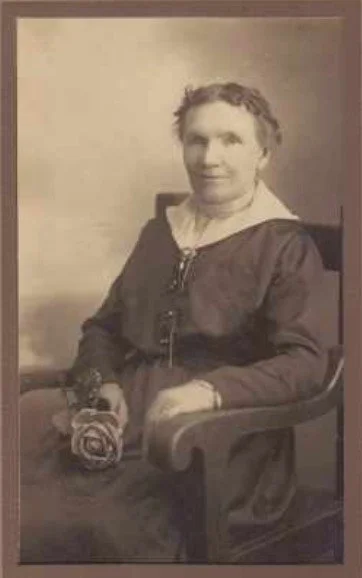A Life of Courage and Devotion: The Story of Bishop McRae’s Wife
Anna Christina Jensen McRae (1844–1932)
Pioneer of the 1857 Captain Cowley Company
From Denmark to Granger — A Life of Faith, Courage, and Community
Anna Christina Jensen McRae was born on October 5, 1844, in Sorø, Denmark, to Jacob and Maren Jensen. Raised on a small farm near the sea, she learned self-reliance early as her family made their own bread, cheese, and cloth. In 1855, her father joined the Church of Jesus Christ of Latter-day Saints, selling the family farm to gather with the Saints in Utah. At age twelve, Anna Christina was baptized in Copenhagen, where she recalled watching ships come into harbor and soldiers drilling on the walls surrounding the city.
In April 1857, the Jensens began their long journey to Zion with the Captain Cowley Company, crossing the Atlantic by sail and then traveling by train and ox team across the plains. She vividly remembered illness, hunger, and storms, yet her tone remained one of endurance and gratitude. The family arrived in the Salt Lake Valley that September, just as Johnston’s Army approached Utah. Following Brigham Young’s direction, they briefly relocated south to Spanish Fork before returning to settle permanently.
Anna Christina married Daniel McRae in the Endowment House on February 1, 1868. After living several years in Salt Lake and Millcreek, they eventually moved west “over Jordan” to the Granger area, where they helped build one of the first schools and later the Granger Ward meetinghouse. Her husband, Daniel, served as the first bishop when the Granger Ward was organized, a calling he held for more than thirty years. He later served as a member of the Utah State Legislature. Together, they raised nine children and became deeply rooted in the growing west-side farming community.
Anna Christina’s life was marked by resilience. She survived a serious train accident in 1892 that left her on crutches for nearly two years and endured several personal losses with remarkable faith. Known for her industriousness, she sewed, quilted, raised poultry, and made butter, while also serving faithfully in church and community causes. She often spoke of her early days in Granger, when neighbors gathered in the small schoolhouse for worship, dancing, and social events—simple joys that helped bind the young community together.
The Ill-Fated 14th South (3500 South) Crossing Accident — Dec 18, 1902
On a cold December evening in 1902, tragedy nearly struck the heart of Granger when Mrs. Christina (Christena) McRae, wife of Bishop Daniel McRae, and her daughter Eunice, age 20, narrowly escaped death at the notorious 14th South (now 3500 South) railroad crossing.
Shortly before six o’clock on December 18, 1902, the two women were driving their buggy toward home as Rio Grande Western Train No. 9 rounded the bend, bound for Salt Lake City. The night was dark, and the train’s approach—hidden by the curve in the tracks—came too suddenly to avoid. Before they realized the danger, the locomotive struck the buggy with devastating force.
The impact completely demolished the carriage, killing the horse instantly and throwing both women several feet from the wreckage. The horse’s body was hurled nearly seventy-five yards from the crossing. Mrs. McRae, then 58 years old, suffered a compound fracture of her left leg just above the ankle and a severe scalp wound above her forehead. Her daughter Eunice received three scalp wounds—one above each eye and another on her forehead—along with a painful shoulder injury.
The train’s engineer brought the locomotive to an abrupt halt and rushed back to the scene. Both women, semiconscious but alive, were carefully lifted aboard the train and transported to St. Mark’s Hospital in Salt Lake City, arriving in record time for medical attention.
The accident renewed widespread concern about the dangerous 14th South crossing, already known among both residents and railroad men as “the dreaded crossing.” The curve in the tracks concealed oncoming trains until they were nearly upon travelers, and several accidents—three or four each year—had occurred at the same spot.
Though their buggy was reduced to splinters, both Mrs. McRae and her daughter survived their ordeal. Their courage and recovery became part of early Granger’s collective memory—a reminder of both the perils and resilience of pioneer life on the west side of the valley.
Widowed in 1917, she lived her later years between the homes of her daughters, Zina Irving and Elmina Kinnersley, remaining cheerful and self-reliant despite declining eyesight. Anna Christina Jensen McRae passed away on August 6, 1932, at age 88. Her funeral was held in the Granger Ward Chapel, and she was laid to rest at Wasatch Lawn Cemetery.
Her life story—spanning from Denmark’s farmlands to the heart of Granger—embodies the courage and devotion of Utah’s early pioneers who shaped both faith and community on the western edge of the valley.


